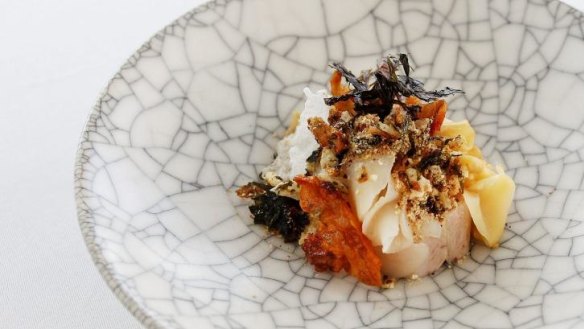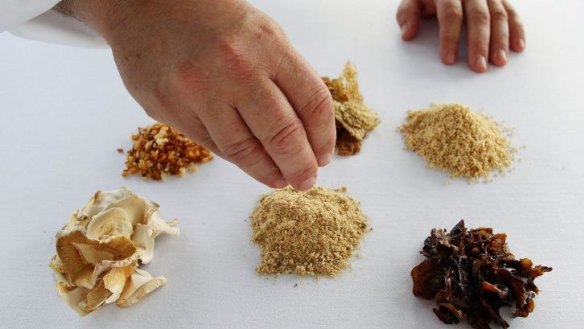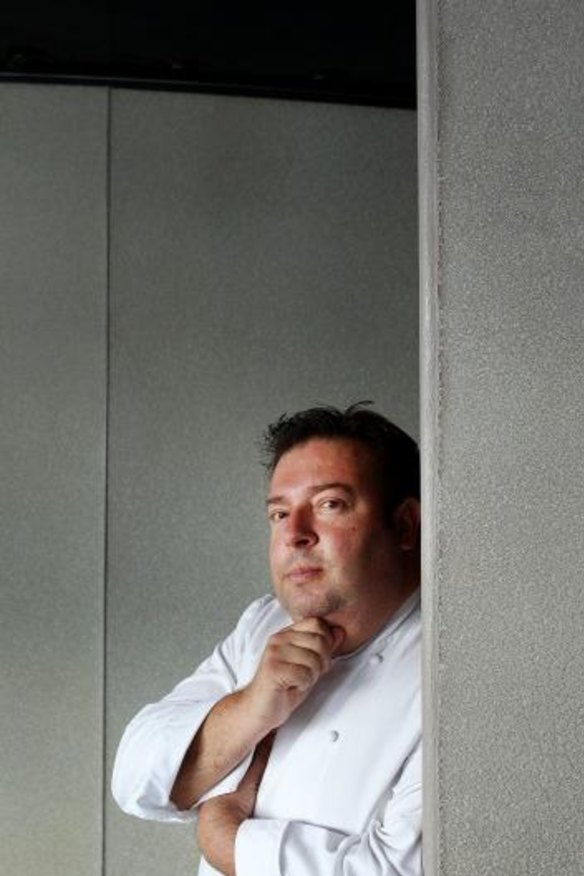The evolution of Peter Gilmore's signature dish
There is a dish that chef Peter Gilmore holds close to his heart, but it is not his Snow Egg.

The menu reads: Smoked and confit pig jowl, roasted koji, shiitake, kombu, Jerusalem artichoke, sea scallop, sesame.
It is a list of ingredients that has inspired Quay chef Peter Gilmore on a 15-year journey involving trial, error, frustration and success.
The formation of the list began at DeBeers, Whale Beach, where Gilmore held the post of Head Chef, ahead of his now dozen years at Quay. "I started experimenting with the Chinese idea of pairing proteins," he says. "In the 1990s chefs were serving duck with scallops and chicken with abalone, for me, combining a confit pig belly and sea scallops made a lot of sense texturally. The fact that they could be plated very geometrically was a bonus."

The dish was first served to DeBeers patrons as two batons of pork belly, a pair of sea scallops balanced on top, and beside them, a small salad of jellyfish and Japanese mushrooms. "It was my first really special dish I think," says Gilmore.
Moving to Quay in 2001 Gilmore took the dish with him, giving it pride of place on his first menu. Then Sydney Morning Herald chief food critic Matthew Evans reviewed Quay in early 2002, scoring it 18/20 and awarding it three hats in the 2003 Good Food Guide.
In his review for Good Living Evans wrote; "He's [Gilmore] taken the food from DeBeers, honed, worked and developed ideas until they are pure harmony in the mouth" and of the pork belly: "There's a hint of China in the amazing crisped pork belly with scallops."

"After Matthew's review the pork belly became my signature dish," says Gilmore. It also signalled the beginning of an obsession with pork belly across Sydney restaurants, which continues to this day.
However, after five years in his repertoire it was time for the dish to evolve. "A lot of my food develops over time, if something inspires me, then I'll begin making changes," says Gilmore. In its next incarnation, silken tofu and shaved green-lipped abalone were added. "When I'm creating, or tweaking a dish, the textural components are as important to me as the marriage of flavours," he says. "Structure, flavour, texture and cultural influences are the driving forces of all of my food."
The third version of the dish began a revision of textures, which, Gilmore has continued to work and rework over the past five years. Shaved squid has appeared, so too tofu, a fresh jersey milk curd, and eventually, a new key ingredient, roasted koji rice, which he credits with imparting the most intriguing aroma on the plate.
Gilmore believes the current version of the dish, now in its seventh incarnation, is the most complex. "We've increased the umami factor," he says. "Umami is a big thing for me, as is fermentation as a means of extracting really great flavours."
The team at Quay begin extracting the intense savoury flavours, some three days before they are sent to the table. A long list of time consuming, labour intensive, intriguing processes and procedures, start with inoculation.
Koji rice is inoculated with aspergillus oryzae - a bacteria which encourages the onset of a mild flavoured, edible white mould; that forms on the exterior of the grain when incubated for 48 hours at 35 C. "During that long incubation process the starches in the rice are converted into amino acids and simple sugars," says Gilmore. "The rice becomes nutty and sweet, and adds to spectrum of umami."
At the same time pig jowl is brined in a hot chicken stock, it is then packed into plastic sleeves and put in a cryovac for 10 hours. In the morning the meat is cold smoked with maple chips for an hour-and-a-half. "This adds further intrigue to the flavour," says Gilmore. Across the kitchen, a confit brew has been made using clarified butter and 30 shaved slices of jamon. The liquid is poured into a plastic cryovac sleeve, to which the jowl is added to steep overnight, ensuring it will be ready for tomorrow night's service.
It is not the only forward prep required. Yesterday several cuttlefish were cleaned, skinned, layered on top of each other and then frozen. They emerge from the freezer as a solid block, sliced, just prior to plating. "It is shaved to order, then quickly poached (15 seconds at 70 C) in a little of the jamon butter mixture," says Gilmore. The frozen shaving and careful heating, is done by a team of three chefs - one on protein, one on plating and one on garnish. Each chef, once the docket appears, knows when to move between freezer, stove and cryovac, finally meeting at the pass, to get this dish on the plate.
Shiitake mushrooms have also been prepared well ahead of service. Sliced on the horizontal they have been lightly salted and cryovaced, then left at room temperature for 24 hours, to ferment slightly. They too require heating in the jamon butter but in a different pan from the cuttlefish.
On plating, the jowl sits at the bottom, then the ribbons of cuttlefish, followed by the mushrooms. On top, a crunchy, crumble-like mixture is spooned, it is the most labour intensive component of the dish, says Gilmore. "We have made this from puffed sushi rice, Jerusalem artichoke shards, roasted kombu and white sesame seeds."
This crunchy topping; has also been a work in progress for several days. Two days ago, a chef was given the task of steaming Jerusalem artichokes in their skins, peeling them by hand, dehydrating them and, a day later, frying them.
Similarly, the sushi rice was puffed by first cooking it until soft, then rolling it between silicon sheets, dehydrating it, frying it in hot oil, before it was carefully broken into pieces – another ingredient that has taken 48-hours to prepare from start to finish.
Likewise, the kombu has been in the dehydrator, fried and broken into pieces. Shiitake skins, also in the mix; were placed on a silicon sheet, brushed with clarified butter and dried in the oven. All of these ingredients are then tossed together at the pass, and spooned on to the top of the dish as Gilmore watches his team of three at work.
"Now, we finished it with a powder which is really 'essence of umami'," he says.
The umami powder, not available in any supermarket, was also knocked up over the past three days in time for its appearance this evening. This sprinkle, of almost invisible powder, is the most important element of the dish's flavour says Gilmore. Made from the roasted inoculated koji rice, roasted kombu, dehydrated fermented shiitakes and toasted white sesame seeds which have been milled in a spice grinder until they are talc-like. "It has a beautiful sweet nuttiness to it. The crumble and the powder really finish the dish both texturally, and in terms of flavour," says Gilmore. "The powder adds and draws out all those layers of umami."
72-hours and 15 years in the making, the plate is ready to be carried to the table.
Organum (Murdoch Books) RRP $100, is Gilmore's just released second book. An iPad app, available exclusively through the Apple Store, has also been released. The app is an interactive journey through Gilmore's recipes in Organum. www.quay.com.au
Restaurant reviews, news and the hottest openings served to your inbox.
Sign up